To be dark matter or not to be dark matter - what does data tell us
Although I have discussed many dark-matter-related topics on my blog, I insist every time on the fact that alternative theories where there is no dark matter also exist. These are also widely studied by physicists.

[image credits: Wikipedia]
This being said, I have never written anything about those alternative theories. I am intending to partly fill this gap with this post.
The topic of the day concerns galactic rotation curves. In other words, this blog post addresses the motion of stars and gas within galaxies.
These galactic rotation curves were the original motivation for introducing dark matter in the 1930s.
But modifying gravity at large distances could be another way to accommodate galaxy rotation curve data.
WHY INTRODUCING DARK MATTER IN THE FIRST PLACE?
The origins of dark matter can be traced back to the 1930s, when a scientist named Fritz Zwicky studied a distant cluster of galaxies named the Coma cluster. His studies consist of the first indirect evidence for dark matter.
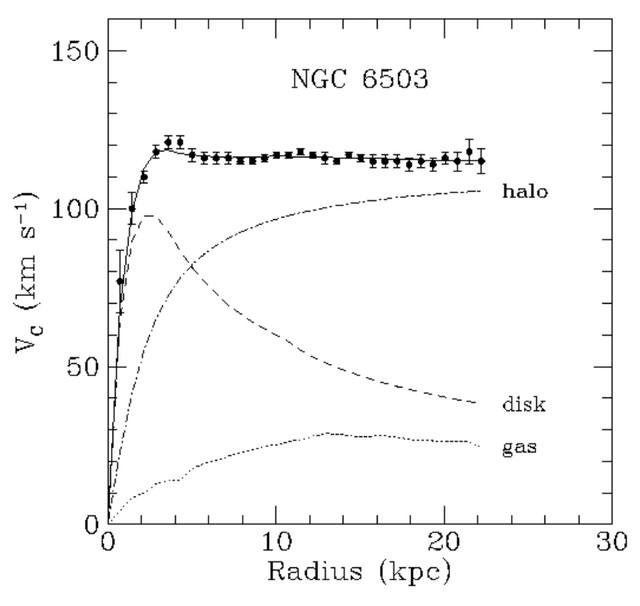
[image credits: arXiv]
The results are illustrated on the picture on the left. In a few words, this figure depicts the circular motion of stars and gas in a distant galaxy.
Let us detail what this figure means more precisely.
To make such a figure, one reports the velocity of the stars as a function of their distance from the galactic center. Those are the data points (squares on the figure).
Now, of course, we want to confront data to theory (this is the scientific method after all). To this aim, we need to superimpose theory predictions to the data points.
One simple way to make predictions is to use Newtonian mechanics (or in other words, standard gravitational interactions). Starting from the mass of the visible stars and gas in the considered galaxy, we obtain the dotted line of the figure (the line labeled as ‘gas’).
It is clear that data and Newtonian mechanics disagree. Zwicky decided to leave gravity as it is and therefore postulates the existence of dark matter.
Including dark matter in the galaxy disk (labeled as ‘disk’) and around the galaxy (labeled as ‘halo’), the sum of all contributions (the solid line) matches data.
From that time, the results of Zwicky have been reproduced in the context of other galaxies, and many extra indirect evidences tend to support the dark matter hypothesis (cosmic microwave background, the formation of structures in the universe, etc.).
IF GRAVITY WAS DIFFERENT FROM WHAT WE THINK IT IS
In order to restore agreement between theory and data, one can postulate the existence of dark matter. This is what we have done in the previous section.
However, this is not the only option. One could equally modify how gravity works at large distances to get a theory-data agreement. In other words, we modify the theory and do not touch the content of the universe.
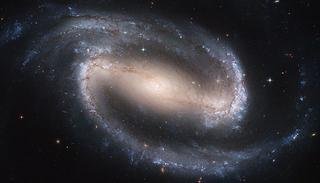
[image credits: Wikipedia]
Those theories are called MOND theories, and were first introduced by Mordehai Milgrom.
MOND is by the way an acronym for MOdification of Newtonian Dynamics. The name speaks for itself.
All the indirect evidences for dark matter can actually be explained in the MOND context too, although in some cases, it is feasible but not that obvious.
By modifying gravity, the dotted ‘gas’ curve in the above figure is modified so that it reproduces the data well.
CAN WE DISENTANGLE DARK MATTER FROM MOND?
Very recently, two physicists reanalyzed 129 galactic rotation curves both in the dark matter and the MOND contexts. They wanted to investigate how differences could appear in the predictions, so that we could potentially exclude one of the two hypotheses.
Their results are available here.
First, in order to be able to find out which hypothesis is the correct one, one needs to design a quantity for which the two predictions are different enough so that conclusive statements can be drawn.
They introduced the so-called g2-space, which consists of a two-dimensional space where two different properties of the stars moving in distant galaxies are reported: gbar and gobs
The first of these quantities, gbar(r), consists of the acceleration that the different stars would get if only the visible matter would be responsible for it. It depends on the distance from the galactic center r.
The second of these quantities, gobs(r), consists of the observed acceleration. Again, it varies with the distance from the galactic center.
Let us now move on with a sketch of what the MOND and dark matter predictions could look like in the g2-space.
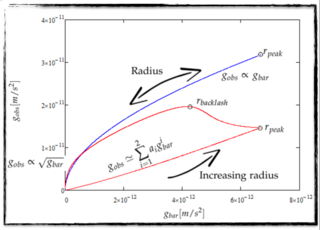
[image credits: arXiv]
For a given star, r is fixed (a star lies at a given distance from the galactic center and that’s it) and one gets a couple of (gbar, gobs) values.
We thus have one couple of values for each star in a galaxy.
In the figure on the left, the predictions for MOND are shown in blue and those for dark matter in red.
When the distance to the galactic center is increased, one starts from the (0,0) point (the origin of the axes) and finally gets to an ‘rpeak point’ that lies at different place on the g2 plane. This consists of the rightmost point in both cases.
Then, when one continues in probing larger r values, the MOND points go back to the origin in the same way they got to the rpeak point, whilst the dark matter points follow another path.
With precise enough data, we have thus a way to disentangle both models as the predictions are totally different.
DATA, DISCUSSION AND REFERENCES
By reporting the (gbar, gobs) values for each star of a given galaxy, one could add data points in the g2-space plane introduced above.
To repeat, as the MOND and dark matter predictions differ by a lot, in particular for small distances, we have a handle to distinguish both models and tell which one is correct and which one is wrong.
Of course, the above picture is a sketch and reality may be slightly different…
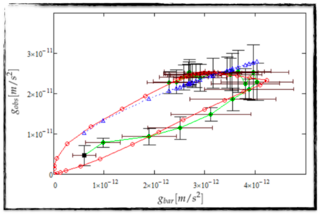
[image credits: arXiv]
In the figure on the right, we investigate a galaxy named NGC 3109. The blue line corresponds to the actual MOND predictions, and the red lines to the dark matter predictions.
The green line consists of data, with the black error bars.
Although it seems that data tends to favor the dark matter hypothesis (in particular on the left of the figure), the error bars are still huge so that one should be careful with conclusions.
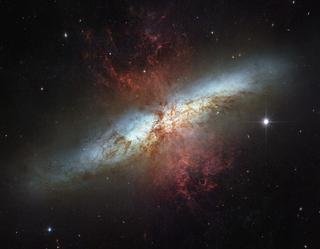
[image credits: Wikipedia]
129 galaxies have been tested, and MOND actually fits the data better for 93 of these galaxies.
But in all cases, the huge error bars do not allow for rejecting the dark matter hypothesis that actually fits the data well too.
On different grounds, large deviations between MOND predictions and data have been found for a significant number of galaxies. We are talking here of deviations at the 3sigma level, which means 1 chance out of 370 that we are unlucky.
To sum up, galaxy rotation curves are one of the very first motivation for dark matter. However, interestingly enough, the MOND non-dark-matter hypothesis cannot be excluded at an extremely good confidence level with curent galaxy rotation curve data.
The future will tell us more, definitely, when more data will be recorded.
For more information, one can have a look first here for general information about MOND and then there for the article in which the MOND and dark matter hypotheses are compared in the context of the galaxy rotation curves.
For more discussion on this topic (or anything related to science), please join us on steemSTEM. SteemSTEM is a community driven project which seeks to promote well written/informative Science Technology Engineering and Mathematics postings on Steemit. More information can be found on the @steemstem blog.
I must admit that much of this was impossible for me to understand, simply because i dont have the basic information that is required to understand it before i started to read.
But i find it interesting and forced my self to read everything, because a little here and a little there will make it more easy to understand similar things when i read about it in the future.
I have of course also my own theories about some of this things, but dont have the basic knowledge to explain it in a sensible way, because i dont know the right words and formular for it.
But i am always happy when i see people who understand and make a clear difference between a theory and facts. :)
(my English is not so very good neither, and that can make it difficult to understand some of the things, when it is a lot of tecnical words involved)
I get so upset when i talk with people who talk about for example "The Big Bang Theory" as a fact, even if the theory even have the word "Theory" in it.. lol
And i even believe in The Big Bang theory as a part of the explanation.
But i know it is a theory.
And then there is also another question i came to think about when i was reading this, does "nothing" exist?
Anyway, thank you for this post.
Even if i did not understand everything, i learned a little more, and it probably made me able to understand even more the nest time.
It also led me to look closer at some of the things here.
I hope you have a great day when you read this. :)
You can always ask questions about things I should clarify. As this is a text and not a live discussion, I can only assume what is easy to understand and what is not :)
To get what a theory is, it is good to go back to the scientific definition of the word. A theory is a mathematical structure precisely explaining the ensemble of all experimental facts of a given domain. It can be used to make predictions and is thus testable. With this respect, the big bang theory, or standard cosmology if you prefer, is a theory. Now, should it stay or be sent top the graveyard of the dead theories, we don't know yet :)
Theory with data is as useless as data without a theory :)
Please define nothing. I am afraid we are entering the domain of philosophy here :p
I'm going to need to start following you, @lemouth. I always enjoy reading about theoretical physics. Although I have a hard time getting my head around dark matter. I read somewhere once that you can't interact with dark matter: you can't feel it, you can't see it. If our galaxy collided with a galaxy made entirely of dark matter, there would be no collision: both galaxies would just fly past each other. So if that's the case (and if I haven't misstated anything), then how could any accounting of mass and motion is our universe require the existence of dark matter? :/
Thanks for your comment.
Actually, dark matter weakly interact with normal matter. In most of the time, nothing happens. However, in very rare events, dark matter interacts with normal matter and these are our hope to directly detect it. There are various experiments on Earth trying to detect these very rare events. For the moment, nothing has been found, but hopefully, something will be found at some point in the following years :)
In the same way, dark matter can self-interact and produce visible stuff. This is how cosmic rays are used to indirectly search for dark matter and this is (one of) the mechanism responsible for the relic density of dark matter present in the universe.
Of course, all of this assumes that there is dark matter.
I hope things are now clearer. Otherwise, do not hesitate to come back to me ;)
Great summary. I was looking forward to reading this post since your last one about the measurement of dark matter. You are an excellent asset to the Steemit community. I have a cursory understanding of dark matter, but I enjoy learning more everyday.
Thanks a lot for this very nice message. I am feeling honored. I like to talk about dark matter, as I work on this topic (which is also why I like to talk about it... we have a kind of loop here :p )
Interesting that a slight adjustment to gravitation theory over great distances might eliminate the need for dark matter. Could dark energy also be accounted for by the same adjustment to gravity theory?
There are frameworks in which dark energy is not really needed and when the effects are in some way dynamically generated. But don't ask me anything about these theories, I have never studied them. I just know they exist.
Thanks
You are welcome!
I heard Neil deGrasse Tyson about dark matter that it is responsible for more than 80% of the gravity in the cosmos and that it is the longest unsolved problem in modern astrophysics. This is just awesome Sir!
I am not sure I would say it is the longest unsolved problem in the Universe (there are problems that are much older), but at least it is a problematics people are working on :)
Ahh I see, I only heard that from him though :)
As I would have liked to have some professor of quantum physics during my career that will explain everything well to me with the dark matter, unfortunately I only know the basic I will try to learn more about it.
The basics are still taught in standard (physics) curriculums. I guess that for more details, you may need to go to advanced schools.
If you have the reason to go to advanced schools to learn more about the subject, unfortunately most professionals specialized in particle physics have emigrated from the country, that is why quantum courses in the 3 universities that give the career of physics in the country are quite deficient. @lemouth
Yeah, this is a pity. I hop things will improve on some future. I also understand people running away when things are getting bad. I would not do so personally, but I can understand why some do.
Hopefully, good resources can be found on the web! :)
it is difficult to find good resources on the web but if the basic and of course friend I hope that everything is solved in my pias soon, I tell you the truth here there is much potential in the area of scientific research
In particle physics, many lecture notes are available on the arXiv. just one click to download them. For more basic course, I agree it may be more complicated, but things exist.
Thank you very much for the data, my friend, I will visit that page @lemouth
I prefer dark matter. It sounds more secret ;)
... and it reinforces the fact that we are "still in the dark" about so many things, from science to civilization / peace
Do you know most of my seminars start like this: "theoretically, we are in the dark, which is why the study of the physics beyond the Standard Model of particle physics is so exciting" :)
Same for me. Personally, I am not a fan of modified gravity theories, but we must stay open-minded.
Thank you!
Your post reminded me on something which does not exactly relate to your topic but nevertheless might be interesting for you.
Have you ever heard of a German mathematician named "Hartmut Warm". He developed a computer program which follows the galactic movements of stars. He called it "the signature of spheres". I found it most astonishing and it gave me inspiration and curiosity about "coincidence" and "order".
You can find him on youtube by typing in his name and "Signatur der Sphären".
I actually don't know the guy. He seems to have not written any peer-reviewed scientific article, which rings an alarm bell with respect to this work. However, as I haven't read anything of his work myself, I will refrain myself from judging it.
PS: I don't have the time to further investigate his theory at the moment. Sorry.
I've read quite a lot about Dark matter from your blog. And anytime I read them, I got my knowledge enhanced. I never knew about dark matter until some months ago
Thanks a lot for your nice comment!
I am linking to a couple of sites you are probably not aware of that you should be:
The way this video is presented is very misleading. I didn't like it at all.
As I actually mentioned it in my post, dark matter theories are well alive, and the proof is data. This does of course not forbid the existence of alternative theories (as again, said in my post), as we cannot disentangle both hypotheses today. Now, the second part of the video is also misleading. For the missing baryon issue, please have a look to my post of last week. This has nothing to do with dark matter, contrary to what the video says...